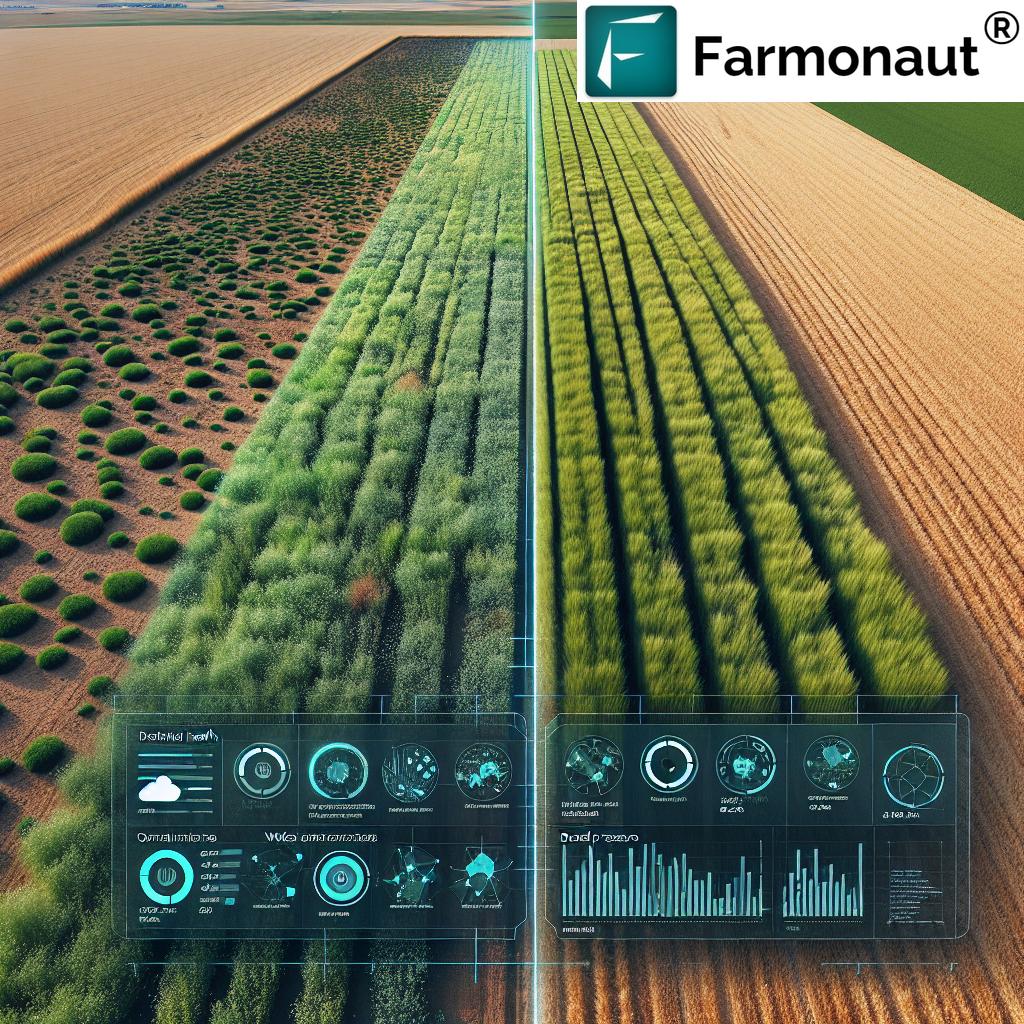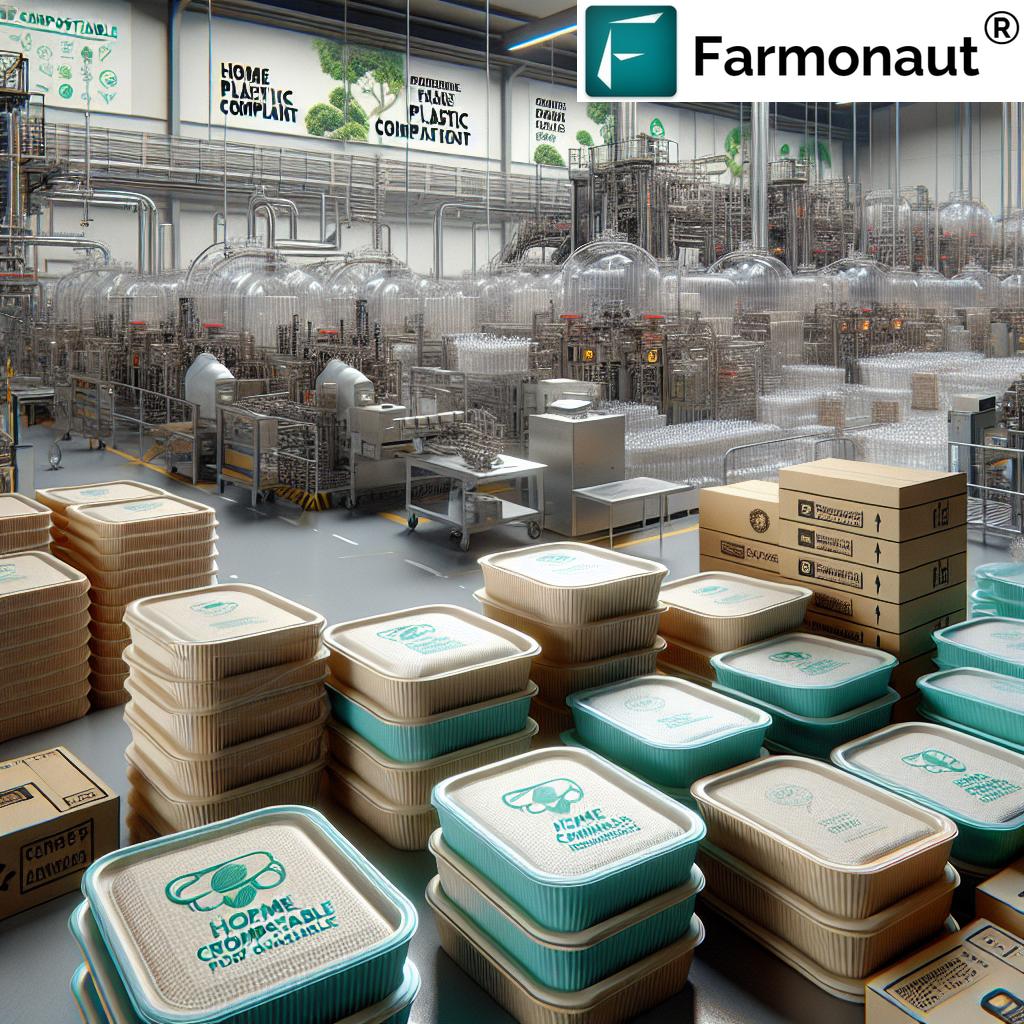Sustainable Lucerne Seed Production: Tackling Herbicide Resistance in South Australia with Integrated Weed Management
“Herbicide resistance threatens lucerne seed production in southeast Australia, impacting 3 major weed species: annual ryegrass, barley grass, and sowthistle.”
In the heart of South Australia’s rural landscape, a silent battle is unfolding. Lucerne seed production, a cornerstone of our agricultural industry, faces a formidable opponent: herbicide-resistant weeds. At Farmonaut, we recognize the urgent need to address this challenge and ensure the sustainability of this crucial pasture species. Join us as we delve into the world of integrated weed management (IWM) strategies and explore how innovative approaches can safeguard the future of lucerne seed production in our region.
The Herbicide Resistance Challenge in South Australian Lucerne Fields
Herbicide resistance has emerged as a significant threat to lucerne seed production in southeast Australia. This issue poses a direct challenge to the sustainability and profitability of one of our most important pasture species. The primary culprits in this unfolding drama are three notorious weeds: annual ryegrass, barley grass, and sowthistle. These persistent plants have developed resistance to commonly used herbicides, making traditional weed control methods increasingly ineffective.
The implications of this resistance are far-reaching. Not only does it threaten the immediate productivity of lucerne fields, but it also puts at risk the long-term viability of herbicide use in our agricultural systems. As we face this challenge, it becomes clear that a more comprehensive and sustainable approach to weed management is necessary.

The Importance of Integrated Weed Management in Lucerne Seed Production
Integrated Weed Management (IWM) represents a holistic approach to tackling the herbicide resistance problem. This strategy combines various weed control methods to create a more sustainable and effective system. By diversifying our tactics, we can reduce reliance on any single method, particularly chemical herbicides, which have been the primary driver of resistance development.
Key components of IWM in lucerne seed production include:
- Crop rotation to disrupt weed life cycles
- Mechanical cultivation techniques
- Biological control methods
- Precision herbicide application
- Cover cropping and competitive planting
By implementing these strategies, we aim to create an environment where herbicide-resistant weeds struggle to thrive, while our lucerne crops flourish. This approach not only addresses the immediate issue of resistance but also promotes long-term soil health and biodiversity.
The Role of Technology in Modern Weed Management
In the fight against herbicide-resistant weeds, technology plays a crucial role. At Farmonaut, we leverage cutting-edge satellite imagery and AI-driven insights to support farmers in their weed management efforts. Our platform provides real-time crop health monitoring, enabling early detection of weed infestations and targeted response strategies.
Explore our advanced agricultural solutions:
By harnessing the power of satellite data and precision agriculture, we can revolutionize how we approach weed control in lucerne fields. This technology allows for more precise application of herbicides, reducing overall usage and minimizing the risk of resistance development.
Comprehensive Weed Survey: Assessing the Extent of Herbicide Resistance
“A comprehensive weed survey in South Australia aims to assess herbicide resistance in key lucerne production areas, covering thousands of hectares.”
To effectively combat herbicide resistance, we must first understand its extent and distribution. That’s why a comprehensive weed survey is currently underway in South Australia’s key lucerne production areas. This survey aims to provide a clear picture of the resistance landscape, covering thousands of hectares across the region.
The survey focuses on three primary objectives:
- Identifying the prevalence of herbicide-resistant weeds in lucerne fields
- Mapping the distribution of resistance across different production areas
- Assessing the effectiveness of current herbicide regimes
By gathering this crucial data, we can develop tailored management strategies that address the specific challenges faced by farmers in different regions. This targeted approach is essential for the effective implementation of integrated weed management practices.
Developing Sustainable Farming Practices for Lucerne Seed Production
As we confront the challenge of herbicide resistance, it’s crucial to develop and implement sustainable farming practices that promote long-term productivity and environmental stewardship. These practices not only address the immediate issue of weed control but also contribute to the overall health and resilience of our agricultural systems.
Key sustainable farming practices for lucerne seed production include:
- Diversified crop rotations to break weed cycles
- Reduced tillage techniques to promote soil health
- Cover cropping to suppress weed growth
- Precision nutrient management to optimize plant health
- Integrated pest management to reduce reliance on chemical controls
By adopting these practices, we can create a more balanced and resilient agricultural ecosystem that naturally suppresses weed growth and reduces the need for herbicide use.
The Economic Impact of Herbicide Resistance on Lucerne Seed Production
The emergence of herbicide-resistant weeds not only poses agronomic challenges but also has significant economic implications for the lucerne seed industry. As traditional weed control methods become less effective, farmers face increased production costs and potential yield losses. This economic pressure underscores the urgency of developing and implementing integrated weed management strategies.
Consider the following economic factors:
- Increased herbicide costs due to the need for multiple applications or more expensive products
- Reduced yields resulting from weed competition
- Additional labor and machinery costs for mechanical weed control
- Potential loss of export markets due to quality issues or contamination
By addressing herbicide resistance through integrated management approaches, we can help safeguard the economic viability of lucerne seed production in South Australia and maintain our competitive edge in global markets.
Innovative Approaches to Weed Control in Lucerne Fields
As we seek solutions to the herbicide resistance challenge, innovation plays a crucial role. New and emerging technologies offer exciting possibilities for more effective and sustainable weed control in lucerne seed production. At Farmonaut, we’re at the forefront of these innovations, leveraging advanced satellite imagery and AI to support precision agriculture practices.
Explore our API for custom agricultural solutions: Farmonaut API
For developers, check out our comprehensive documentation: API Developer Docs
Some innovative approaches to weed control include:
- Precision spraying technologies that target individual weeds
- Robotic weeders for mechanical control without soil disturbance
- Bioherbicides derived from natural compounds
- Gene editing techniques to enhance crop competitiveness
- Drone-based weed mapping and targeted treatment
These technologies, combined with the insights provided by platforms like Farmonaut, offer new possibilities for managing weeds in lucerne fields while minimizing environmental impact and reducing the risk of herbicide resistance.

The Role of Research and Development in Combating Herbicide Resistance
Ongoing research and development efforts are crucial in the fight against herbicide resistance in lucerne seed production. Scientists, agronomists, and industry partners are working collaboratively to develop new strategies and tools to manage resistant weeds effectively. This research spans various disciplines, including plant biology, soil science, and agricultural technology.
Key areas of research include:
- Developing new herbicide modes of action
- Breeding lucerne varieties with enhanced weed competitiveness
- Investigating the genetic mechanisms of herbicide resistance
- Evaluating the effectiveness of non-chemical weed control methods
- Studying the long-term impacts of integrated weed management strategies
By investing in research and development, we can stay ahead of evolving weed resistance and continue to develop effective, sustainable solutions for lucerne seed production.
The Importance of Education and Extension in Weed Management
Effectively combating herbicide resistance requires more than just technological solutions; it demands a well-informed and skilled agricultural workforce. Education and extension programs play a vital role in disseminating knowledge about integrated weed management strategies and best practices to farmers, agronomists, and other stakeholders in the lucerne seed industry.
Key components of effective education and extension programs include:
- Workshops and field days demonstrating IWM techniques
- Online training modules on herbicide resistance management
- Collaborative research projects involving farmers and scientists
- Development of decision support tools for weed management
- Regular updates on emerging resistance trends and control strategies
By empowering our agricultural community with knowledge and skills, we can ensure the widespread adoption of sustainable weed management practices across South Australia’s lucerne seed production areas.
The Future of Lucerne Seed Production in South Australia
As we look to the future of lucerne seed production in South Australia, it’s clear that addressing herbicide resistance will be crucial for the industry’s long-term sustainability and success. By embracing integrated weed management strategies, leveraging innovative technologies, and fostering a culture of continuous learning and adaptation, we can overcome the challenges posed by resistant weeds.
The future of lucerne seed production will likely be characterized by:
- More diverse and resilient farming systems
- Increased adoption of precision agriculture technologies
- Greater emphasis on ecological approaches to weed management
- Stronger collaboration between farmers, researchers, and industry partners
- Continued innovation in plant breeding and crop protection
At Farmonaut, we’re committed to supporting this vision by providing cutting-edge tools and insights that empower farmers to make informed decisions and implement effective weed management strategies.
Integrated Weed Management Strategies for Lucerne Seed Production
| Strategy Name | Target Weeds | Effectiveness Rating (1-5) | Environmental Impact | Implementation Cost |
|---|---|---|---|---|
| Crop Rotation | Annual ryegrass, Barley grass, Sowthistle | 4 | Low | Medium |
| Mechanical Cultivation | Annual ryegrass, Barley grass | 3 | Medium | Medium |
| Biological Control | Sowthistle | 2 | Low | High |
| Precision Herbicide Application | Annual ryegrass, Barley grass, Sowthistle | 5 | Medium | High |
| Cover Cropping | Annual ryegrass, Barley grass | 3 | Low | Low |
Conclusion: A Sustainable Path Forward for Lucerne Seed Production
The challenge of herbicide resistance in South Australia’s lucerne seed production is significant, but not insurmountable. By embracing integrated weed management strategies, leveraging innovative technologies, and fostering collaboration across the industry, we can ensure the continued success and sustainability of this vital agricultural sector.
As we move forward, it’s crucial that we:
- Continue to invest in research and development
- Adopt and refine integrated weed management practices
- Embrace precision agriculture technologies
- Prioritize education and knowledge sharing
- Remain adaptable in the face of evolving challenges
At Farmonaut, we’re committed to supporting farmers and the broader agricultural community in this journey towards more sustainable and resilient lucerne seed production. Together, we can overcome the threat of herbicide resistance and secure a thriving future for South Australia’s agricultural lands and waters.
FAQs
- What is herbicide resistance, and why is it a problem in lucerne seed production?
Herbicide resistance occurs when weeds develop the ability to survive herbicide applications that would typically control them. In lucerne seed production, this is problematic because it reduces the effectiveness of traditional weed control methods, potentially leading to yield losses and increased production costs. - How does integrated weed management (IWM) help combat herbicide resistance?
IWM combines multiple weed control strategies, reducing reliance on any single method. This approach helps prevent the development of herbicide resistance by using diverse tactics, including cultural, mechanical, and chemical controls. - What role does technology play in managing herbicide-resistant weeds?
Technologies like satellite imagery, AI-driven insights, and precision agriculture tools help farmers identify weed infestations early, apply targeted treatments, and monitor the effectiveness of their management strategies. - How can farmers implement sustainable practices in lucerne seed production?
Farmers can adopt practices such as crop rotation, reduced tillage, cover cropping, and precision nutrient management. These methods promote soil health, suppress weed growth, and reduce reliance on chemical controls. - What are some innovative approaches to weed control in lucerne fields?
Emerging technologies include precision spraying, robotic weeders, bioherbicides, gene editing for crop competitiveness, and drone-based weed mapping and treatment.
















